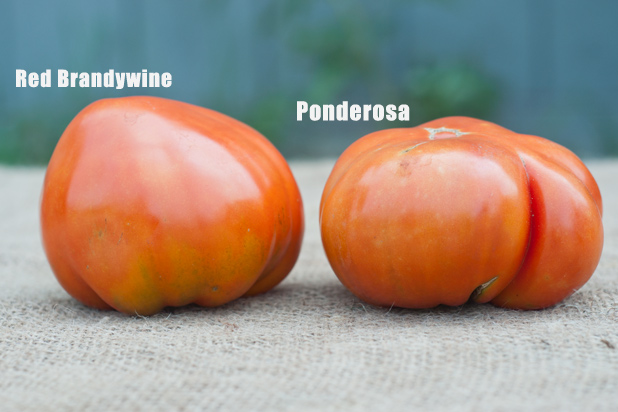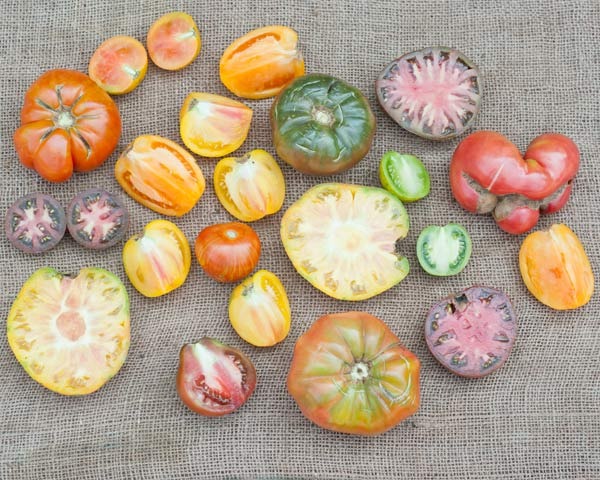Heirloom Tomatoes: Everything You Need To Know
So, you've decided you're going to stop religiously using your Seamless account and start cooking more, and you might even be pledging to yourself to visit your neighborhood farmers' market every Sunday, too. You're going to get back to the earth and start cooking with natural, fresh, and locally grown foods, and you're going to learn everything you can about those foods while doing so, so that you can seem like you've been behind this farm-to-table movement the whole time.
Here's your first lesson: heirloom tomatoes.
Click here to see 19 Different Heirloom Tomato Varieties (Slideshow)
You may have heard of them. These legendary, beautiful creatures are all some people can talk about once late July or early August hits, when their season begins and their round, beautifully colored and bulbous shapes start filling the tables at farmers' markets and CSAs. While an heirloom tomato is definitely a significant distinction in itself from the varieties you find at your grocery store all year round, calling one of them an "heirloom" is merely looking at the first page of a 3,000-page yearbook. There are thousands, even tens of thousands, of varieties of heirloom tomatoes, each marked by different physical traits, tastes, and origins. When you're buying an heirloom tomato, you're buying a specific one, and it's going to taste and feel different from, say, the one it was sitting next to on the shelf.
The number of heirloom varieties grown in this world is hard to pin down, and that's because they are open-pollinated plants that were originally grown because Mother Nature, or whoever, decided they should be. This distinction makes them different from the tomatoes you find all year round, which are known as hybrid tomatoes, because they're grown with genetic modifications specifically tailored for optimal size, color, and durability — so they hold up being stocked by the hundreds and transported millions of miles in a large truck to your grocery store. Besides the fact that these tomatoes are not naturally grown, their modifications often tend to leave out taste, so while they look pretty and last a week in the produce aisle, they're going to need more than salt and olive oil to be delicious.
It's now probably clear why heirloom tomatoes make people as crazy as they do. They're naturally grown, incredibly luscious in flavor, and they're highly sought-after and cherished when found. When you do see one, it's very unlikely that it was grown more than 100 miles from where you're standing at that point in time.
To find our heirloom tomatoes, The Daily Meal traveled to Mendham, N.J., and visited Bennett Haynes of Ralston Farm. Haynes started his farm in 2011 and, in addition to supplying local restaurants, he now operates a CSA that caters to 90 members with his fresh, locally grown crops. Along with his crops, pigs, ducks, and flowers he has growing on his farm, he has 19 different varieties of heirloom tomatoes sprouting out of the Earth, too.
Haynes knew each one of his varieties with the same intimate knowledge he knew the names of his pigs, and he walked us through 19 of them, explaining their differences in taste, growing conditions, and their stories. Stories, you might ask? Yes, because each heirloom is open-pollinated and naturally created, each has a history behind it that doesn't involve chemicals in a lab. Take the Paul Robeson, named after a civil rights activist because of its deep, rich purple coloring; or the Emmy, which was given its name to pay tribute to the creators' friend who fled to Romania after World War II. Haynes even had a variety with a story directly connected to him, because he snuck its highly coveted seeds away from a watchful woman in Genoa, Italy, so that he could grow his own.
Some heirlooms' virtues are less about their history and more about their looks, like the Green Zebra, which has stripes that resemble those found on the exotic animal, or the Pink Brandywine, which is so beautifully and vibrantly, well, pink. These stories and their physical characteristics are how Haynes was able to distinguish one out of a group of 30 sitting in a box. You may think that one is a Ponderosa, but if you look at it from eye level you'll see that its pointy bottom gives it away (and makes it hard to stand it upright).

And the flame reference with the Jaune Flamme may not click right away, but just wait until you cut it open. Along with the differences between the varieties, Haynes also pointed out just how unique each individual variety can be, by showing us how three different Dester heirlooms had different shapes and different seals, which bind their skins together on their bottoms.

We met 19 of these kitchen heroes, and we're going to keep searching so that we can meet more and more. When you head to the farmers' stand this weekend, see if you can spot a few of these varieties — you'll seem like a natural and ordering takeout will be a thing of the past.
Anne Dolce is the Cook editor at The Daily Meal. Follow her on Twitter @anniecdolce
